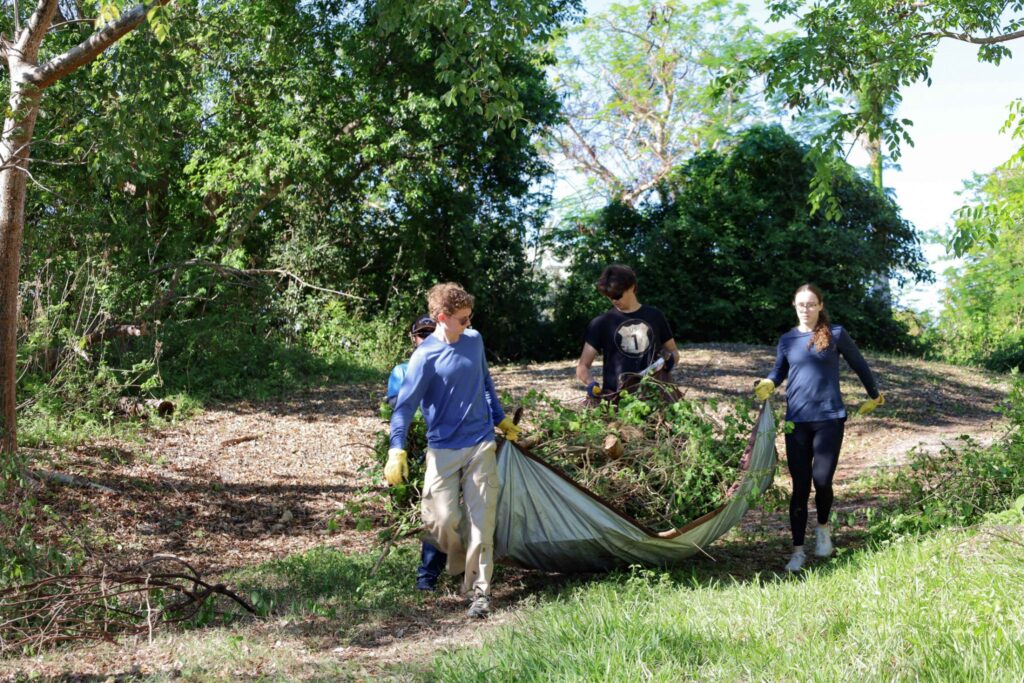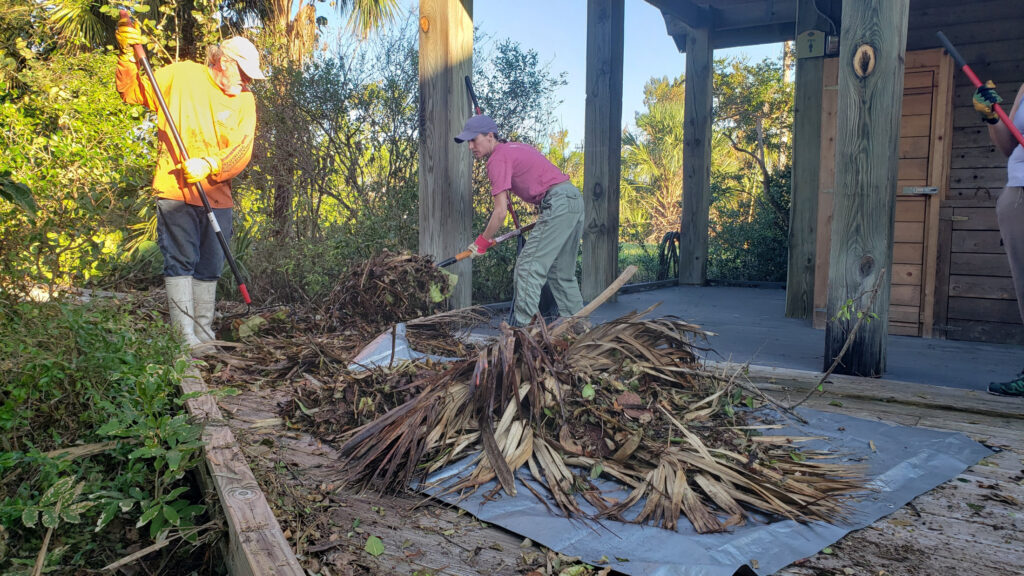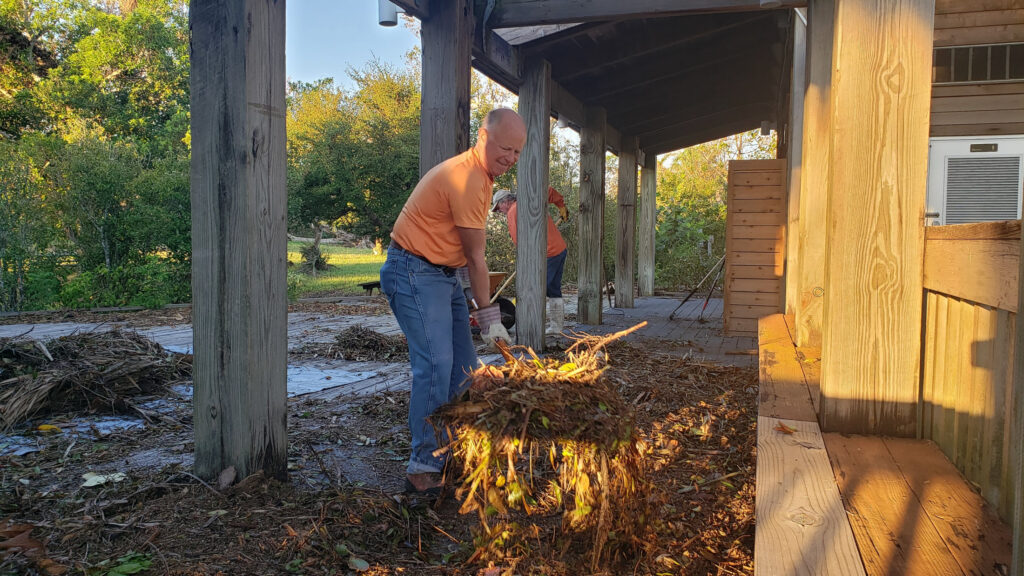By Jerald Pinson, Florida Museum of Natural History
The Florida Museum’s Randell Research Center was hit by two major hurricanes this past year. Helene rolled along the Gulf Coast in September, and less than a month later, Milton slammed into the peninsula between Tampa and Fort Myers at a nearly 90-degree angle.
The area was subjected to 120 mph winds and storm surge that flooded houses and cultural heritage sites. But the Randell Research Center has experienced many such storms throughout its long history, and when the skies cleared from Helene and Milton, people got to work.
“Our staff and volunteers conducted an onsite evaluation, identified and removed hazards, cordoned off damaged areas and removed storm surge debris, which was a huge effort,” said Michelle LeFebvre, curator of South Florida archaeology and ethnography at the Florida Museum of Natural History and director of the Randell Research Center. “Scrubbing down flooring and decking from storm surge mud deposits that made it into the classroom and gift shop was another big task.”

The Randell Research Center was established in 1996 to ensure the preservation of a historically significant area. The site’s nearly 70 acres is located on Pine Island in Southwest Florida and encompasses several Indigenous shell mounds created over hundreds of years by the Calusa. Most of South Florida’s mounds were demolished and used as construction material for roads in the early 20th century. The mounds at Randell are among the few that remain.
Later in November, a team of GatorCorps members and UF Gulf Scholar students visited the center to lend a helping hand. GatorCorps is a branch of the AmeriCorps program with headquarters at the Florida Institute for Built Environment Resilience (FIBER) at the University of Florida. The program was established to create national service pathways through FIBER, bolstering preparations for natural disasters and helping communities adapt to climate change.
“Disasters are a disruption to the status quo, which presents an opportunity for change in a society,” said Jason von Meding, the executive director of GatorCorps and professor in the Rinker School of Construction Management at UF. “Usually, there are companies and individuals that are ready to exploit that opportunity, and we want to support people who just want to help each other make the positive changes that are needed.”
The UF Gulf Scholars program accepts students from diverse backgrounds and provides them with the training and experience needed to address pressing issues facing the Gulf region of the United States. The program is housed in the UF Bob Graham Center for Public Service and offers several resources to scholars, including Gulf-focused academic courses, internships and research opportunities, field excursions and professional networking.
“As hurricanes and other natural disasters intensify, we will rely on a wide variety of skill sets to adapt and plan for the future,” said Rebecca Burton, UF Gulf Scholars program coordinator. “We hope our programming will help students develop a strong sense of place and shared mission to ensure our state’s ability to support future generations.”

Both groups work in several locations throughout Florida, including Jacksonville, Cedar Key, Gainesville and Fort Myers, where they work directly with communities and local businesses.
“A big focus for us is resilience education and helping local organizations build capacity to use resilience tools and techniques,” von Meding said.
LeFebvre, who began her term as director this summer, sees parallels between resilience in today’s communities and those of the past. For over 1,000 years, Southwest Florida was home to the Calusa. Their capital city was located at Mound Key, 25 miles southeast of the Randell Research Center, and their towns dotted the coastline.
A large portion of their diet — and building material — consisted of mollusks. The thick-walled shells of oysters clams, conches and whelks were used to create massive foundations up to 30 feet high, on top of which they constructed vast halls and temples.
These mounds served several purposes. The elevated platform gave the Calusa a broad view of the sea, allowing them to spot visitors well in advance of their arrival. It also put them out of reach of mosquitos and other biting insects that prefer to fly close to the ground. Just as important, the mounds provided protection against hurricanes. Structures built on top of the mounds were well above the reach of floodwaters, and the permeable shell base easily withstood gale-force winds.
As climate change continues to brew increasingly stronger and more frequent hurricanes, LeFebvre thinks protecting the cultural history of the Calusa is imperative, both to learn from their resilient tactics that allowed them to persist for a millennium and as a means of defining who we are and where we live.

“People from different walks of life and histories can visit the site, and all of them will have different insights into strength and resilience to take away with them,” she said. “There’s resilience in the everyday aspects of hurricane recovery, but there’s also resilience in realizing we’re part of a much larger history and legacy of living with and responding to climate change.”
GatorCorps students who visited the center echoed this sentiment.
“It feels really nice to be part of the same cycle. People built this to live on, and now we get to come back and restore it,” said Amaya Borroto, an undergraduate student majoring in Sustainability in the Built Environment at UF.
The team helped remove invasive vegetation that had grown up over one of the shell mounds. As they removed the thick mat of vines and shrubs, the shells appeared beneath them, where they’d been for hundreds of years. Many of the shells had small holes punched through them, a placeholder showing where someone had scraped out the mollusk.
“It’s intimate evidence of what daily life was like here,” said Hayden Germanis, a UF student majoring in landscape architecture. “Coming out here has been really inspiring. Being from the area, I heard a lot about the Calusa my whole life, but I had no idea about the scale of their existence. It’s hard to comprehend, especially when you learn this is just a small part of what is left of it.”
Annisa Karim, operations manager for the Randell Research Center, said partnerships like these are a crucial for building climate change resilience and strengthening communities.
“Hurricanes take a long-term mental and physical toll,” she said. “When you see people coming from somewhere else to help get your community back to normal, it shows the rest of the world is paying attention and cares. These students may not have the opportunity to come back here for years depending on where their lives take them, and for them to come as a group for a weekend and work on a site to get us back to normalcy means a lot.”
Banner image: Staff members, including Sarah Mercier (center), help clear away tree limbs downed by Hurricane Helene and Milton. (Florida Museum). This piece was originally published at https://www.floridamuseum.ufl.edu/science/randell-research-center-teams-up-with-gatorcorps-and-gulf-scholars-to-tackle-climate-change-on-pine-island-florida/.
Sign up for The Invading Sea newsletter by visiting here. To support The Invading Sea, click here to make a donation. If you are interested in submitting an opinion piece to The Invading Sea, email Editor Nathan Crabbe at ncrabbe@fau.edu.


